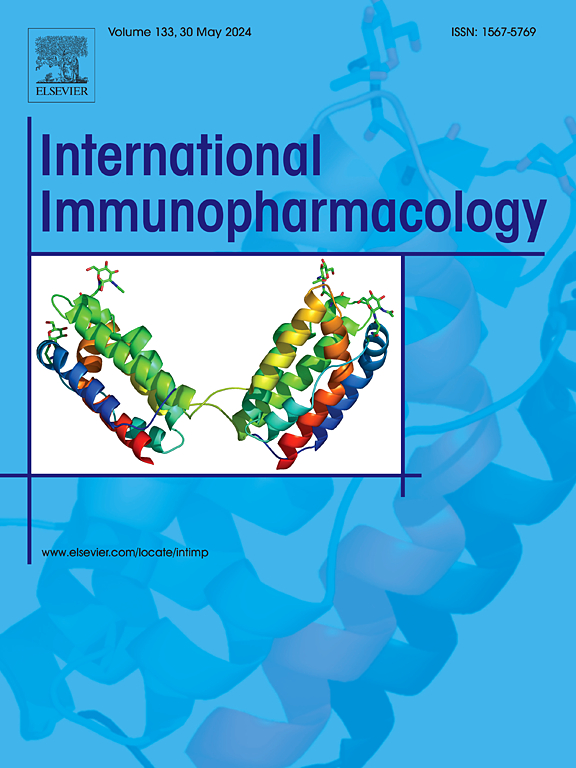Gentiopicroside ameliorates synovial inflammation and fibrosis in KOA rats by modulating the HMGB1-mediated PI3K/AKT signaling axis
IF 4.8
2区 医学
Q2 IMMUNOLOGY
引用次数: 0
Abstract
Background
Knee osteoarthritis (KOA) is a degenerative joint disease characterized by synovial inflammation and fibrosis. Gentiopicroside (GPS), one of the main active ingredients of Gentiana macrophylla, is widely used in anti-inflammatory and anti-fibrotic therapies. However, the exact mechanism by which GPS treats synovial inflammation and fibrosis in KOA remains unclear.
Methods
Fibroblast-like synoviocytes (FLSs) were stimulated with lipopolysaccharide (LPS) to induce inflammation and fibrosis, and CCK-8 was performed to determine the viability of GPS-treated FLSs, using immunofluorescence to examine the expression of P-PI3K and P-AKT, confocal microscopy was used to identify intracellular HMGB1 translocation. The KOA rat model was established by anterior cruciate ligament transection (ACLT) and subsequently subjected to GPS intervention. Inflammatory cytokines (TNF-α, IL-1β, and IL-6), fibrosis-related indicators (TGF-β, collagen I, TIMP1, and α-SMA), and HMGB1/PI3K/AKT signaling axis-related proteins and gene expression of fibroblast-like synoviocytes and synovial tissues were detected by Western blotting and real-time PCR. The histopathology of the synovium of the rats was assessed using Hematoxylin-eosin (HE), Sirius Red, and Masson staining. Immunohistochemistry was performed to detect the expression of HMGB1, P-PI3K, and P-AKT.
Results
The present study revealed that GPS intervention significantly ameliorated inflammation and fibrosis in LPS-stimulated FLSs and KOA rat synovium. Immunofluorescence demonstrated that GPS inhibited the release of HMGB1 from the nucleus. Furthermore, GPS intervention down-regulates the levels of proteins and gene associated with the HMGB1/PI3K/AKT signaling pathway.
Conclusion
GPS ameliorated synovial inflammation and fibrosis in KOA rats, which may involve HMGB1-mediated activation of the PI3K/AKT signaling axis.
求助全文
约1分钟内获得全文
求助全文
来源期刊
CiteScore
8.40
自引率
3.60%
发文量
935
审稿时长
53 days
期刊介绍:
International Immunopharmacology is the primary vehicle for the publication of original research papers pertinent to the overlapping areas of immunology, pharmacology, cytokine biology, immunotherapy, immunopathology and immunotoxicology. Review articles that encompass these subjects are also welcome.
The subject material appropriate for submission includes:
• Clinical studies employing immunotherapy of any type including the use of: bacterial and chemical agents; thymic hormones, interferon, lymphokines, etc., in transplantation and diseases such as cancer, immunodeficiency, chronic infection and allergic, inflammatory or autoimmune disorders.
• Studies on the mechanisms of action of these agents for specific parameters of immune competence as well as the overall clinical state.
• Pre-clinical animal studies and in vitro studies on mechanisms of action with immunopotentiators, immunomodulators, immunoadjuvants and other pharmacological agents active on cells participating in immune or allergic responses.
• Pharmacological compounds, microbial products and toxicological agents that affect the lymphoid system, and their mechanisms of action.
• Agents that activate genes or modify transcription and translation within the immune response.
• Substances activated, generated, or released through immunologic or related pathways that are pharmacologically active.
• Production, function and regulation of cytokines and their receptors.
• Classical pharmacological studies on the effects of chemokines and bioactive factors released during immunological reactions.

 求助内容:
求助内容: 应助结果提醒方式:
应助结果提醒方式:


